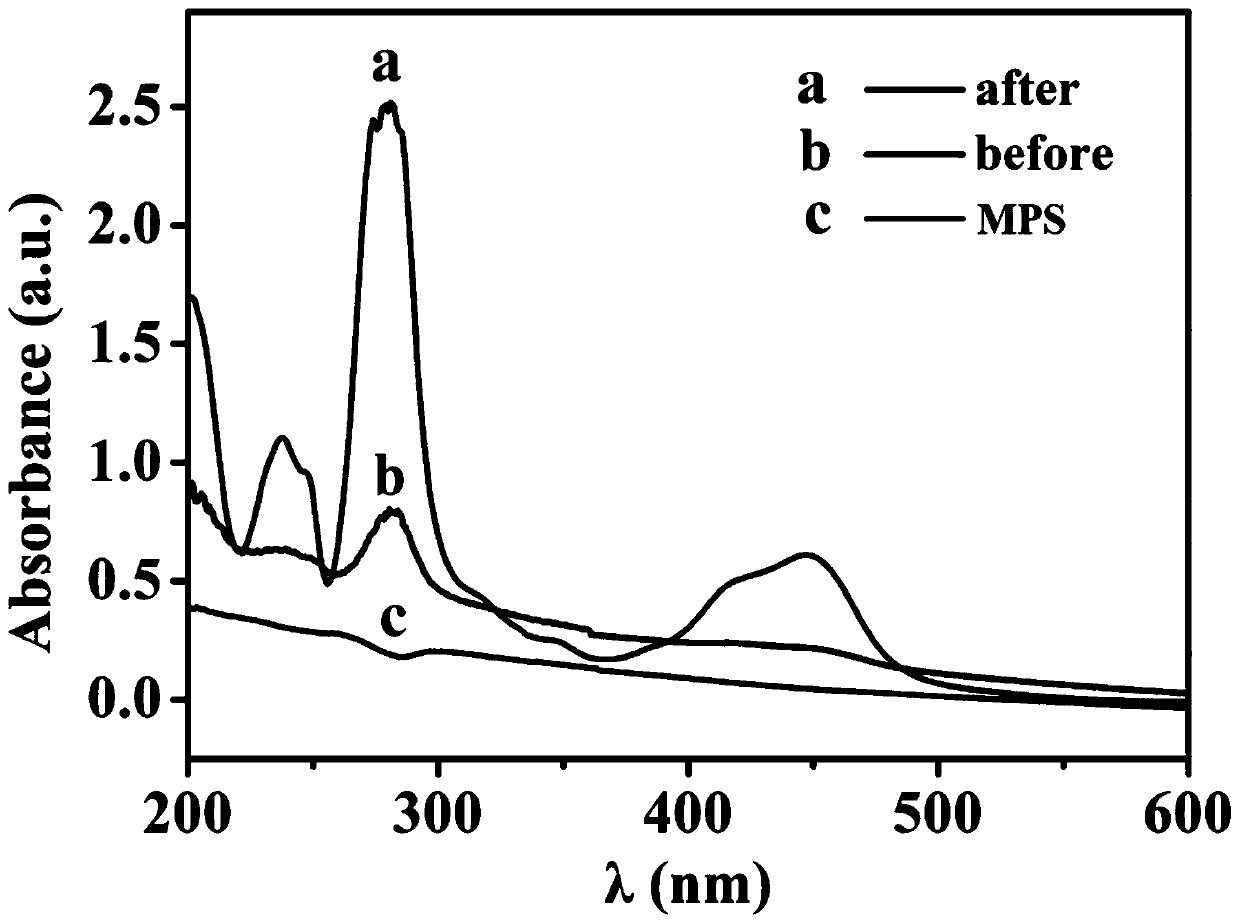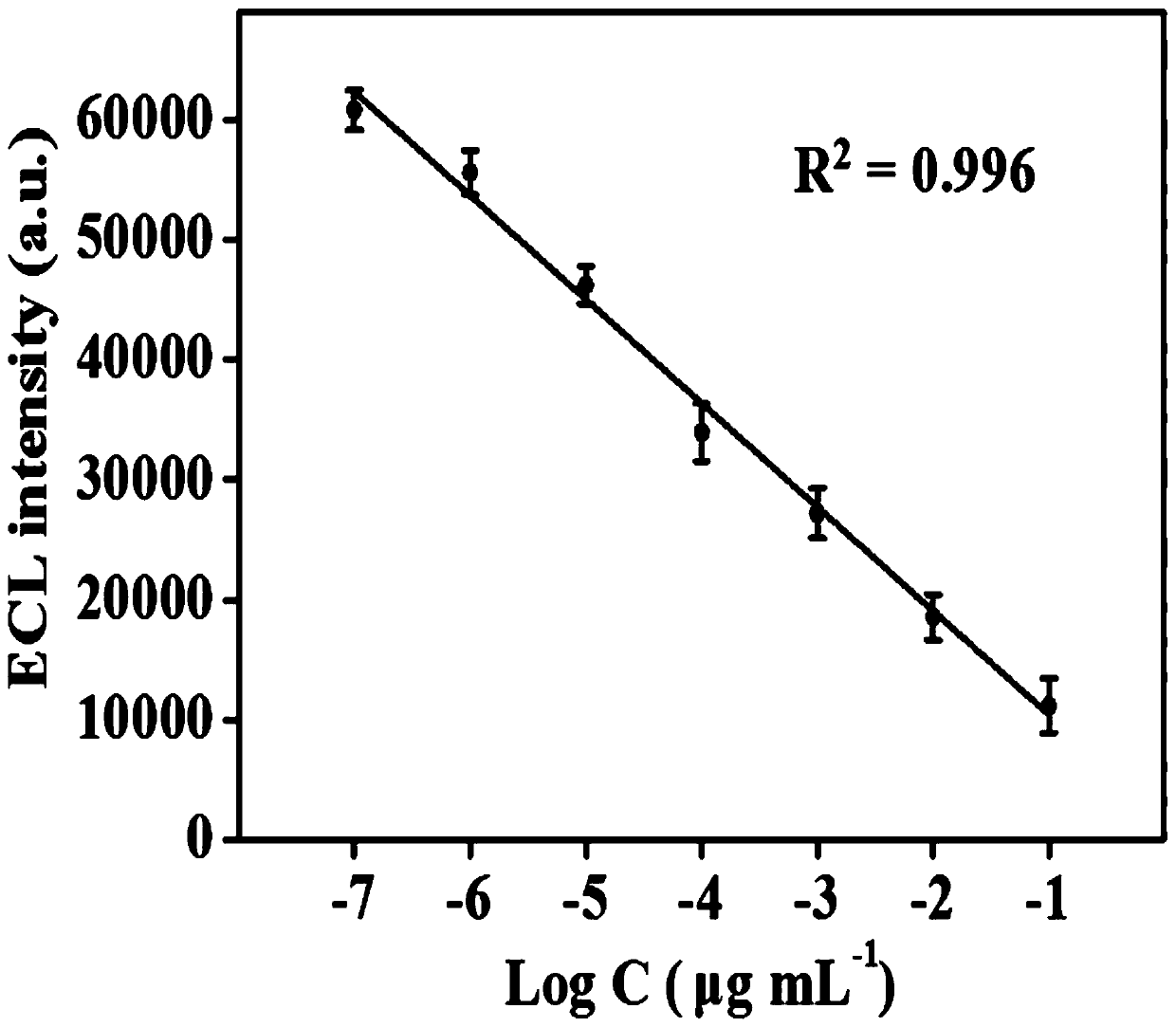Photo-thermal release signal enhanced type thyroglobulin electrochemiluminescence immunosensor
A thyroglobulin and signal-releasing technology, applied in electrochemical variables of materials, scientific instruments, instruments, etc., can solve the problems of inability to directly functionalize immune complexes, limit the application of TPA solid-phase luminescence, etc., and achieve highly sensitive detection, The effect of enhancing the ECL signal
- Summary
- Abstract
- Description
- Claims
- Application Information
AI Technical Summary
Problems solved by technology
Method used
Image
Examples
Embodiment 1
[0026] A method for preparing an electrochemiluminescent immunosensor based on photothermal release signal enhancement:
[0027] (1) Pretreatment of the glassy carbon electrode: the glassy carbon electrode is first mechanically polished and polished on the suede covered with alumina powder, washed with secondary water to remove the residual powder on the surface, and then moved into an ultrasonic water bath for cleaning until it is cleaned, and finally Wash thoroughly with ethanol, dilute acid and water;
[0028] (2) Mix 50 μL of 10 mg / mL mesoporous silica (MPS) aqueous solution with 50 μL of 10 mM bipyridyl ruthenium [Ru(bpy) 3 2+ ] The solution was shaken and absorbed for 6 h, and the mixture was centrifuged for 10 min to obtain the precipitate, which was washed and diluted with 100 μL of ultrapure water; then, 10 μL of 3-aminopropyltriethoxysilane (APTES) was added to the solution to functionalize After washing with ultrapure water for 12 h, 10 μL of 5 wt.% glutaraldehyde...
Embodiment 2
[0034] Preparation of mesoporous silica (MPS) used in Example 1: Weigh 0.5 g of cetyltrimethylammonium bromide (CTAB) and dissolve it in 240 mL of ultrapure water, add 3.5 mL of 2.0 M sodium hydroxide Solution, the temperature of the mixed solution was raised to 80 °C under full stirring, and the reaction was incubated for 30 min, and 2.5 mL of tetraethyl orthosilicate (TEOS) was slowly added dropwise, and then the stirring reaction was continued at 80 °C for 2 h, and the mixture was centrifuged for 10 min , the obtained precipitate was washed three times with ultrapure water and ethanol, and a white solid was obtained after vacuum drying; finally, 0.5 g of the obtained solid was added to a mixed solution of 50 mL of methanol and 2.5 mL of 37wt.% concentrated hydrochloric acid, heated to reflux for 16 h, The filtered precipitate was washed three times with ultrapure water and methanol, and dried under vacuum at 60 °C to remove the residual solvent in the pores to obtain mesopor...
Embodiment 3
[0037] A thyroglobulin electrochemiluminescent immunosensor based on photothermal release signal enhancement to detect thyroglobulin, the steps are as follows:
[0038] (1) Using a three-electrode system for measurement, the MPS-Ru(bpy) prepared in Example 1 3 2+ / TEPA / TG / Ab / MB modified electrode is the working electrode, Ag / AgCl is the reference electrode, platinum wire electrode is the auxiliary electrode, and the thyroglobulin is detected on the electrochemical workstation, and the electrochemical workstation and the chemiluminescence detector are combined Connect and set the high voltage of the photomultiplier tube to 700 V, the cyclic voltammetry scanning potential range is 0 ~ 1.6 V, and the scanning rate is 0.15 V / s; (2) In PBS with pH 8.0, by electrochemiluminescence method, the 1×10 -1 μg / mL~1×10 -7 Measure the electrochemiluminescence signal intensity generated by a series of thyroglobulin standard solutions with different concentrations on the modified electrod...
PUM
 Login to View More
Login to View More Abstract
Description
Claims
Application Information
 Login to View More
Login to View More - R&D
- Intellectual Property
- Life Sciences
- Materials
- Tech Scout
- Unparalleled Data Quality
- Higher Quality Content
- 60% Fewer Hallucinations
Browse by: Latest US Patents, China's latest patents, Technical Efficacy Thesaurus, Application Domain, Technology Topic, Popular Technical Reports.
© 2025 PatSnap. All rights reserved.Legal|Privacy policy|Modern Slavery Act Transparency Statement|Sitemap|About US| Contact US: help@patsnap.com



